How to deal with melon (cotton) aphids on tomatoes
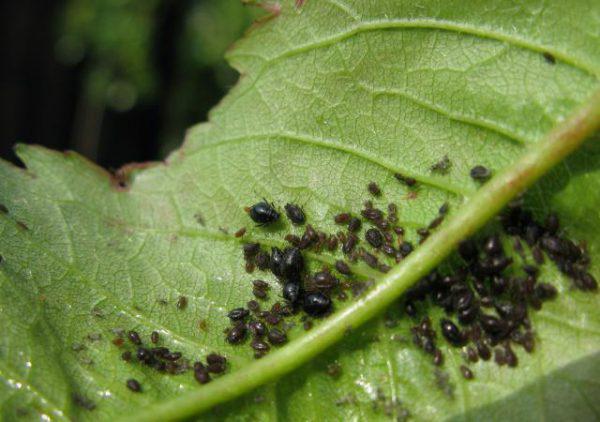
Gourd aphid affects many crops, in particular tomatoes. Settling on the underside of the leaves, the insect sucks all the juices from the young leaves, as a result of which the plant dies.
Once on a tomato bush, the aphid spreads quickly throughout the garden, not giving a chance for survival to either young or mature tomatoes.
Pest description
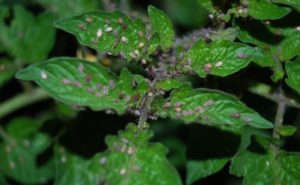 In nature, there are more than 3 thousand species of aphids. Gourd aphid (it is also called cotton) is a tiny creature with wings (there are individuals and wingless), 1.5 millimeters in size. It belongs to the family of aphids. The Latin name is Aphis gossypii.
In nature, there are more than 3 thousand species of aphids. Gourd aphid (it is also called cotton) is a tiny creature with wings (there are individuals and wingless), 1.5 millimeters in size. It belongs to the family of aphids. The Latin name is Aphis gossypii.
The color of the pest's calf can be different: yellow or green with dozens of variations of shades. The body is oval, elongated. The insect has a small proboscis, which pierces the leaf plate and pulls nutrients from it. Visually, the adult resembles rice grain. The product of the life of an insect is a sticky sugary substance (honeydew), the so-called pad.
With its sweet aroma, the pad attracts ants, which act as protectors for melon crops against other insects. There are cases when aphids winters in an anthill. And with the arrival of warmth, the hospitable hosts transfer lodgers to plants.
The main features of the parasite - gluttony and fecundity. This creature can be called omnivorous, because apart from tomatoes, it loves to feast on melons, watermelons, cucumbers, and zucchini. If time does not take measures to destroy the pest, then on tomatoes it can give for the summer up to several generations. Only females participate in reproduction.
Wintering sites for larvae of aphid and females - wingless virgins - basal leaves of perennial grasses, remnants of vegetable plants, as well as various sheltered places protected from the cold. They especially like to accumulate in greenhouses: in a warm climate, they are able to develop throughout the winter period. In the spring, as soon as the temperature rises above 5 degrees Celsius, insects of all orders are activated: the larvae crawl to the seedlings, and the adults fly away in search of juicy grass. At the same time, they lay hundreds of eggs on weeds, and if seedlings are already planted in the greenhouse, the laying is done right in the leaf axils.
The activity of the pest on tomatoes is somewhat reduced in mid-summer, when it becomes too hot. In addition, natural enemies — large insects and birds — help to significantly reduce its population in summer. In the beginning of autumn, a new wave is observed - with the advent of a more comfortable temperature, the aphid returns to the tomatoes, with even more zeal it begins to devour the leaves. On melon crops aphid can develop up to the onset of frost.
This is a frost-resistant insect that can withstand temperatures down to -10 degrees. A pest can die at lower temperatures, as well as during a sharp increase in degree to a 30-degree mark.
Signs of aphids on tomatoes
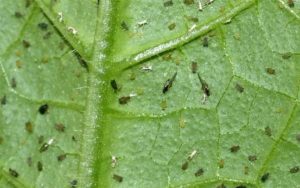 Aphids fall on tomato planting in different ways: through weeds, purchased seedlings, soil, insects. With the onset of heat, females begin to breed, forming a large colony.
Aphids fall on tomato planting in different ways: through weeds, purchased seedlings, soil, insects. With the onset of heat, females begin to breed, forming a large colony.
The melon-field is located on the lower side of the leaves growing on young stalks, shoots. Symptoms of aphids on tomatoes:
- twisting, shrinking young foliage;
- sticky whitish bloom appears on the shoots - waste products of the pest;
- tomato bush stops growing;
- There are many ants in the garden.
If you look at the leaf plate, you can notice a dark, infested mass - this is a rapidly reproducing aphid. Sucking vegetable juices, it disrupts the process of photosynthesis in plants. But besides this, the aphid by its influence poisons the plant with toxins. Because of this, the plant can not consume adequate amounts of nitrogen. Tomatoes become weak and vulnerable. Leaves, shoots are deformed, dry out, fruits become small and clumsy. Their taste spoils.
Treatment
To combat aphids, if she managed to increase her family, it is possible only with the help of chemical insecticides. In case of a small population, it is possible to get rid of the pest using biological preparations or products prepared on the basis of natural components. It is noted that many folk remedies quite successfully cope with melon, if it has just appeared on the tomato garden.
Physical methods
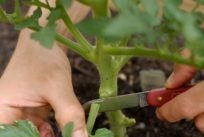 If the aphids on the leaves is small, then it can be destroyed manually, crushing between the leaves. Strongly affected leaves are best removed from the bush, burn outside the garden. It is also worth eliminating weed residues that are lying on the ground - pests also multiply in them.
If the aphids on the leaves is small, then it can be destroyed manually, crushing between the leaves. Strongly affected leaves are best removed from the bush, burn outside the garden. It is also worth eliminating weed residues that are lying on the ground - pests also multiply in them.
The easiest way is to sprinkle the tomatoes using sprinkler irrigation, so the parasites will be washed off with a stream of water. However, this will not mean that you won: only one battle was won, as the aphid from the garden did not go away, but only got on the ground. Soon she again attacks tomatoes.
Experts recommend attracting aphids to catch her natural enemies - insect predators. As you know, ladybugs, golden-eyed, spiders, beetles, wasps, and birds are not averse to try a dozen individuals at a time. To increase the number of beneficial insects on the site, you can use sweet baits, setting feeders and birdhouses.
Folk methods
In the early stages of infection to cope with aphids can folk remedies. They are harmless to plants and humans, they can be used many times per season. Numerous solutions, infusions, various broths spray tomato bushes and the ground beneath them.
Useful formulations:
- a solution of vegetable oil (400 grams), grated soap (100 grams) and 10 liters of water;
- an infusion of 500 grams of wormwood, yarrow, dandelion, chamomile, celandine (all plants have an unpleasant smell and taste), 5 liters of water and 100 grams of soap;
- ash-soap solution from one glass of ash, 200 grams of liquid soap (or dishwashing detergent) and a bucket of water;
- tobacco infusion of 500 grams of dry powder per liter of boiling water. The concentrate is diluted with 10 liters of water. Tobacco can be replaced by a shag;
- soda mixture, consisting of 100 grams of soda, poured a bucket of boiling water;
- alcohol solution from water, liquid ammonia (2 tablespoons), 50 milliliters of liquid soap;
- infusion of garlic and water;
- a solution of a liter of milk with the addition of 10 drops of iodine;
- a weak concentrate of vinegar mixed with water;
- 100 grams of finely chopped peeled onions, diluted in two liters of water, then infused during the day. For the best effect, add soap to the solution;
- kilogram inflorescences marigolds mixed with water, leave to infuse. Before processing the mixture is filtered;
- 800-900 grams of fresh potato tops soaked in water, add bitter pepper. Sprayed 4 hours after preparation.
To leave a useful solution on the leaves for as long as possible, you should always add a little soap into it.
Chemicals
Chemistry is recommended to use if the number of pests has reached global proportions and other means can not cope with the problem.
Chemical insecticides can be used only before and after flowering, as well as during the formation of fruits. 21 days before harvesting, treatment with poisons should be stopped, otherwise the toxins will get inside the fruit. In this case, tomatoes will become dangerous for consumption.
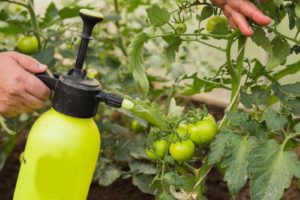 The use of chemicals can be detrimental to tomatoes, if the dosage is broken. Therefore, it is important to follow the instructions. So the bushes can be treated with the same karbofos, which cultivate the land when digging, but then the dosage will be reduced almost twice. For therapeutic spraying, you need to take only 40 grams of the drug per 10 liters of water. When processing plants, it is important to pay special attention to the underside of the leaves - this is where melons are accumulated.
The use of chemicals can be detrimental to tomatoes, if the dosage is broken. Therefore, it is important to follow the instructions. So the bushes can be treated with the same karbofos, which cultivate the land when digging, but then the dosage will be reduced almost twice. For therapeutic spraying, you need to take only 40 grams of the drug per 10 liters of water. When processing plants, it is important to pay special attention to the underside of the leaves - this is where melons are accumulated.
Best Insecticides:
- Commander - a systemic insecticide, which is based on the substance Imidacloprid. Once inside the body, the drug causes a breakdown in the nervous system. To process one weave, dilute 5 ml of the drug and 10 liters of water.
- Actellic is a non-systemic drug that acts directly on the pest. Poisoning the insect from the inside. On the garden with tomatoes will require the preparation of a working solution of 2 milliliters of the drug and 1 liter of water.
- Karate Zeon is an enteric-contact drug. The solution is prepared from 1 ml of the substance and 10 liters of water.
- Spark - a drug for integrated plant protection from pests. To prepare one insecticide tablet is dissolved in 10 liters of water. On 10 square meters two liters of ready solution will suffice.
- Fury - the drug acts on the insect's central nervous system, causing paralysis. The finished solution consists of 1 milliliter of Fury and 10 liters of water.
Biological pesticides
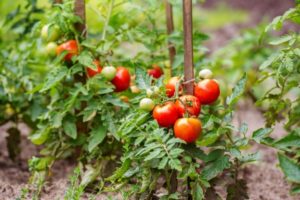 In contrast to chemical agents, biological ones are created on the basis of living microorganisms — fungi and bacteria, which fully show their effectiveness in combating harmful animal life.
In contrast to chemical agents, biological ones are created on the basis of living microorganisms — fungi and bacteria, which fully show their effectiveness in combating harmful animal life.
Most popular tools:
- Biotlin - the drug destroys adults and larvae. The solution is prepared from 5 milliliters of the substance, 10 liters of water. This means enough for landing area of 30 square meters.
- Phytoverm is a preparation based on the metaplasm of fungi found in the soil. The action of the substance occurs through the stomach, so the tool is effective only for adults. Requires 3-4 one-time processing. The working solution is prepared from 10 liters of water and 2 milliliters of the drug.
- Actofit - the effect of the drug is based on blocking the neuromuscular impulse of an adult individual. The solution is prepared from 8 milliliters of funds and 1 liter of water.
Preventive measures
To avoid the appearance of insects on tomatoes, using timely protective measures.
Seasonal preventive manipulations:
- In the autumn after harvesting it is necessary to thoroughly clean the land from plants in which pests are hiding. The earth needs to be deeply dug up - so it is possible to destroy the laying of eggs in soil disputes;
- In the spring before planting seedlings on the bed, the land should be treated with insecticides such as Malathion (60 grams per bucket of water). Moreover, they carry out disinfection of the frame, and the walls of the greenhouse - all surfaces are washed with manganese solution or treated with blue vitriol.
- Along tomato beds along with seedlings are planted odorous plants that repel insects - marigold, lupine, dandelion, wormwood, dill, celery.
- The anthill found on the site must be moved outside the site.
- You should regularly inspect tomato bushes for pests. If lesions are found, it is better to remove them from the plant.
Aphids are attracted to such plants as viburnum, narustiya, kosmeya, begonia, poppy, linden, mallow. Therefore, tomato beds should not be placed next to these bushes.
Conclusion
Gourd aphid - the most malicious pest of tomatoes. It causes severe damage to landings, depriving the cottager of most of the crop. It will be difficult to cope with a rapidly growing population, however, it is much easier to destroy a pest on time than when it multiplies its colony many times. Combating the parasite needs to be carried out in a comprehensive manner: competent agricultural engineering, prevention and regular insecticide spraying will help win the war for the harvest.

